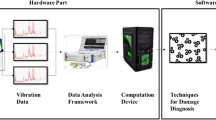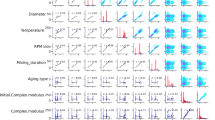Abstract
The corrosion problem in the conventional steel reinforcement in concrete structures has diverted the researchers to explore alternative materials. As a substitute to replace the traditional steel bars in reinforced concrete structures, innovative reinforcement such as fiber reinforced polymer (FRP) rebars has been suggested. Consequently, different codes and guidelines have been proposed for forecasting the shear strength of FRP reinforced members using traditional empirical methods and neural networks. The current paper concentrates on the development of a hybrid intelligence model, namely an artificial neural network articulated with a Bayesian optimization algorithm (ANN-BOA) for estimating the shear strength of these types of members without stirrups. Totally, 216 specimens, collected from the literature, were used in this analysis. The input parameters of the model were beam depth, the ratio of shear span and depth, effective reinforcement ratio, and concrete strength. The ANN hyperparameters (viz. neuron numbers in the hidden layer, learning rate) have been tuned automatically to get the best predictions. The estimated shear strengths are compared with the recent design provisions of Japan (JSCE), UK (BISE), Italy (CNR-DT 203), Canada (CHBDC, CSA S806), and the USA (ACI 440.1R). The results were also compared with a similar ANN model. It was observed that the predicted results using the proposed method are better than those of the other methods in terms of some statistical as well as performance measuring parameters with a maximum Pearson correlation coefficient (R) value of 0.97. These values are higher than the other investigated methods.










Similar content being viewed by others
References
Islam MS, Alam S (2013) Principal component and multiple regression analysis for steel fiber reinforced concrete (SFRC) beams. Int J Concr Struct Mater 7:303–317. https://doi.org/10.1007/s40069-013-0059-7
Islam MS, Ahmed SJ (2018) Influence of jute fiber on concrete properties. Constr Build Mater 189:768–776. https://doi.org/10.1016/j.conbuildmat.2018.09.048
Kotynia R, Szczech D, Kaszubska M (2017) Bond Behavior of GRFP Bars to Concrete in Beam Test. Proc Eng 193:401–408
ACI440.1R (2015) Guide for the design and construction of structural concrete reinforced with fiber-reinforced polymer bars (ACI440.1R-15). Farmington Hills
ASCE (1998) Recent approaches to shear design of structural concrete (ASCE ACI-445). J Struct Eng 124:1375–1417. https://doi.org/10.1061/(ASCE)0733-9445(1998)124:12(1375)
Yost JR, Gross SP, Dinehart DW (2001) Shear strength of normal strength concrete beams reinforced with deformed GFRP bars. J Compos Constr 5:268–275. https://doi.org/10.1061/(ASCE)1090-0268(2001)5:4(268)
El-Sayed AK, El-Salakawy EF, Benmokrane B (2006) Shear capacity of high-strength concrete beams reinforced with fiber-reinforced polymer bars. ACI Struct J. https://doi.org/10.14359/15316
Bentz EC, Vecchio FJ, Collins MP (2006) Simplified modified compression field theory for calculating shear strength of reinforced concrete elements. ACI Struct J 103:614–624. https://doi.org/10.14359/16438
ASCE (1998) Recent approaches to shear design of structural concrete. ACI-ASCE 98. J Struct Eng 124:1375–1417. https://doi.org/10.1061/(ASCE)0733-9445(1998)124:12(1375)
Michaluk R, Rizkalla S, Tadros G, Benmokrane B (1998) Flexural behavior of one-way concrete slabs reinforced by fiber reinforced plastic reinforcement. ACI Struct J 95:353–365
Deitz DH, Gesund H, Harik IE (1999) One-way slabs reinforced with glass fiber reinforced polymer reinforcing bars. ACI Symp Publ. https://doi.org/10.14359/5629
Razaqpur AG, Isgor OB (2006) proposed shear design method for frp-reinforced concrete members without stirrups. ACI Struct J 103:93–102. https://doi.org/10.14359/15090
Tureyen AK, Frosch RJ (2002) Shear tests of FRP-reinforced concrete beams without stirrups. ACI Struct J. https://doi.org/10.14359/12111
JSCE (1997) Recommendation for design and construction of concrete structures using continuous fiber reinforcing materials. Japan Society of Civil Engineers, Tokyo
BISE (1999) Interim guidance on the design of reinforced concrete structures using fibre composite reinforcement. BISE, London
CNR-DT-203 (2006) Guide for the design and construction of concrete structures reinforced with fiber-reinforced polymer bars. Cnr-Dt-203/2006 39
CAN/CSA-S6 (2014) Canadian highway bridge design code
CSA S806 (2012) Design and construction of building structures with fibre-reinforced polymers. CSA S806–12. Rexdale, Ontario, Canada
ACI 440.1R (2006) Guide for the design and construction of structural concrete reinforced with fiber-reinforced polymer bars. ACI 440.1R-06. Farmington Hills
Nguyen QH, Ly HB, Nguyen TA et al (2021) Investigation of ANN architecture for predicting shear strength of fiber reinforcement bars concrete beams. PLoS ONE 16:1–22. https://doi.org/10.1371/journal.pone.0247391
Pham BT, Nguyen MD, Van DD et al (2019) Development of artificial intelligence models for the prediction of compression coefficient of soil: an application of Monte Carlo sensitivity analysis. Sci Total Environ 679:172–184. https://doi.org/10.1016/j.scitotenv.2019.05.061
Ly HB, Le LM, Duong HT et al (2019) Hybrid artificial intelligence approaches for predicting critical buckling load of structural members under compression considering the influence of initial geometric imperfections. Appl Sci. https://doi.org/10.3390/app9112258
Van Dao D, Ly HB, Trinh SH et al (2019) Artificial intelligence approaches for prediction of compressive strength of geopolymer concrete. Materials (Basel). https://doi.org/10.3390/ma12060983
Van DD, Jaafari A, Bayat M et al (2020) A spatially explicit deep learning neural network model for the prediction of landslide susceptibility. CATENA 188:104451. https://doi.org/10.1016/j.catena.2019.104451
Mashrei MA (2011) Prediction of the shear strength of concrete beams reinforced with fiber reinforced polymer bars using artificial neural networks model. Thi Qar Univ J Eng Sci 2:45–63
Bashir R, Ashour A (2012) Neural network modelling for shear strength of concrete members reinforced with FRP bars. Compos Part B Eng 43:3198–3207. https://doi.org/10.1016/j.compositesb.2012.04.011
Lee S, Lee C (2014) Prediction of shear strength of FRP-reinforced concrete flexural members without stirrups using artificial neural networks. Eng Struct 61:99–112. https://doi.org/10.1016/j.engstruct.2014.01.001
Yavuz G (2019) Determining the shear strength of FRP-RC beams using soft computing and code methods. Comput Concr 23:49–60. https://doi.org/10.12989/cac.2019.23.1.049
Naderpour H, Poursaeidi O, Ahmadi M (2018) Shear resistance prediction of concrete beams reinforced by FRP bars using artificial neural networks. Meas J Int Meas Confed 126:299–308. https://doi.org/10.1016/j.measurement.2018.05.051
Naderpour H, Haji M, Mirrashid M (2020) Shear capacity estimation of FRP-reinforced concrete beams using computational intelligence. Structures 28:321–328. https://doi.org/10.1016/j.istruc.2020.08.076
Amani J, Moeini R (2012) Prediction of shear strength of reinforced concrete beams using adaptive neuro-fuzzy inference system and artificial neural network. Sci Iran 19:242–248. https://doi.org/10.1016/j.scient.2012.02.009
Jumaa GB, Yousif AR (2018) Predicting shear capacity of FRP-reinforced concrete beams without stirrups by artificial neural networks, gene expression programming, and regression analysis. Adv Eng Softw. https://doi.org/10.1155/2018/5157824
Alam MS, Gazder U (2020) Shear strength prediction of FRP reinforced concrete members using generalized regression neural network. Neural Comput Appl 32:6151–6158. https://doi.org/10.1007/s00521-019-04107-x
Al-Musawi AA, Alwanas AAH, Salih SQ et al (2020) Shear strength of SFRCB without stirrups simulation: implementation of hybrid artificial intelligence model. Eng Comput 36:1–11. https://doi.org/10.1007/s00366-018-0681-8
Wu J, Chen X-Y, Zhang H et al (2019) Hyperparameter optimization for machine learning models based on bayesian optimization. J Electron Sci Technol 17:26–40. https://doi.org/10.11989/JEST.1674-862X.80904120
Alkhrdaji T, Wideman MA, Belarbi A, Nanni A (2001) Shear strength of GFRP RC beams and slabs. In: Figueiras J, Juvandes L, Faria R (eds) Proceedings 3rd international conference on composites in construction, Porto, Portugal. A.A. Balkema Publishers, Netherlands, pp 409–414
Massam L (2001) The behavior of GFRP reinforced concrete beams in shear. University of Toronto, Toronto
Gross SP, Yost JR, Dinehart DW, Svensen E, Liu N (2003) Shear strength of normal and high strength concrete beams reinforced with gfrp bars. In: International conference on high performance materials in bridges, Hawai, USA. https://doi.org/10.1061/40691(2003)38
Matta F, El-Sayed A, Nanni A, Benmokrane B (2013) Size effect on concrete shear strength in beams reinforced with fiber-reinforced polymer bars. ACI Struct J 110:617–628
Tariq M, Newhook J (2003) Shear testing of FRP reinforced concrete without transverse reinforcement. Proc Annu Conf Can Soc Civ Eng 2003:1330–1339
Razaqpur AG, Isgor BO, Greenaway S, Selley A (2004) Concrete contribution to the shear resistance of fiber reinforced polymer reinforced concrete members. J Compos Constr 8:452–460. https://doi.org/10.1061/(ASCE)1090-0268(2004)8:5(452)
Zhang B, Masmoudi R, Benmokrane B (2004) Behaviour of one-way concrete slabs reinforced with CFRP grid reinforcements. Constr Build Mater 18:625–635. https://doi.org/10.1016/j.conbuildmat.2004.04.007
Ashour AF (2005) Flexural and shear capacities of concrete beams reinforced with GFRP bars. Constr Build Mater 20:1005–1015. https://doi.org/10.1016/j.conbuildmat.2005.06.023
El-Sayed AK, El-Salakawy EF, Benmokrane B (2006) Shear strength of FRP-reinforced concrete beams without transverse reinforcement. ACI Struct J 103:235–243. https://doi.org/10.14359/15181
El-Sayed A, El-Salakawy E, Benmokrane B, El-Sayed AK, El-Salakawy EF, Benmokrane B (2005) Shear strength of one-way concrete slabs reinforced with fiber-reinforced polymer composite bars. J Compos Constr 9:147–157. https://doi.org/10.1061/(ASCE)1090-0268(2005)9:2(147)
El-Sayed AK, El-Salakawy EF, Benmokrane B (2006) Shear capacity of high-strength concrete beams reinforced with FRP bars. ACI Struct J 103:383–389. https://doi.org/10.14359/15316
Guadagnini M, Pilakoutas K, Waldron P (2006) Shear resistance of FRP RC beams: experimental study. J Compos Constr 10:464–473. https://doi.org/10.1061/(ASCE)1090-0268(2006)10:6(464)
Steiner S, El-Sayed AK, Benmokrane B et al (2008) Shear Strength of Large-Size Concrete Beams Reinforced with Glass FRP Bars. In: CSCE (ed) 5th International conference on advance composites materials in bridges and structures. CSCE, Winnipeg
Alam MS, Hussein A (2013) Size effect on shear strength of frp reinforced concrete beams without stirrups. J Compos Constr 17:507–516. https://doi.org/10.1061/(ASCE)CC.1943-5614.0000346
Alam MS, Hussein A (2011) Experimental investigation on the effect of longitudinal reinforcement on shear strength of fibre reinforced polymer reinforced concrete beams. Can J Civ Eng. https://doi.org/10.1139/L10-126
Alam MS, Hussein A (2012) Effect of member depth on shear strength of high-strength fiber-reinforced polymer-reinforced concrete beams. J Compos Constr. https://doi.org/10.1061/(ASCE)CC.1943-5614.0000248
Bentz EC, Massam L, Collins MP, Bentz EC, Massam L, Collins MP (2010) Shear strength of large concrete members with FRP reinforcement. J Compos Constr 14:637–646. https://doi.org/10.1061/(ASCE)CC.1943-5614.0000108
Olivito RS, Zuccarello FA (2010) On the shear behaviour of concrete beams reinforced by carbon fibre-reinforced polymer bars: an experimental investigation by means of acoustic emission technique. Strain 46:470–481. https://doi.org/10.1111/j.1475-1305.2009.00699.x
Zeidan M, Barakat MA, Mahmoud Z, Khalifa A (2011) Evaluation of concrete shear strength for FRP reinforced beams. In: Structures congress 2011—Proceedings of the 2011 Structures congress. pp 1816–1826. https://doi.org/10.1061/41171(401)158
Ashour AF, Kara IF (2014) Size effect on shear strength of FRP reinforced concrete beams. Compos Part B Eng 60:612–620. https://doi.org/10.1016/j.compositesb.2013.12.002
Kim CH, Jang HS (2014) Concrete shear strength of normal and lightweight concrete beams reinforced with FRP bars. J Compos Constr 18:1–9. https://doi.org/10.1061/(ASCE)CC.1943-5614.0000440
Grieef S (1996) GFRP Dowel bars for concrete pavement. MSc Thesis. University of Manitoba
Kotsovos MD, Pavlovic MN (1998) Ultimate limit-state design of concrete structures: a new approach. Thomas Telford Ltd, London
Jain AK, Chandrasekaran B (1982) 39 Dimensionality and sample size considerations in pattern recognition practice. Handb Stat 2:835–855
Raudys SJ, Jain AK (1991) Small sample size effects in statistical pattern recognition: recommendations for practitioners. IEEE Trans Pattern Anal Mach Intell 13:252–264. https://doi.org/10.1109/34.75512
Mockus J (1989) Global optimization and the bayesian approach. D. Reidel Publishing Company, Dordrecht
Snoek J, Larochelle H, Adams RP (2012) Practical Bayesian optimization of machine learning algorithms. In: Proceedings of the 25th international conference on neural information processing systems, pp 2951–2959
Shahriari B, Swersky K, Wang Z et al (2016) Taking the human out of the loop: a review of Bayesian optimization. Proc IEEE 104:148–175
Rasmussen CE (2006) Gaussian processes for machine learning: book webpage. MIT Press, Cambridge
Kumar A, Luo J, Bennett GF (1993) Statistical evaluation of lower flammability distance (LFD) using four hazardous release models. Process Saf Prog 12:1–11. https://doi.org/10.1002/prs.680120103
Kumar A, Bellam NK, Sud A (1999) Performance of an industrial source complex model: predicting long-term concentrations in an urban area. Environ Prog 18:93–100. https://doi.org/10.1002/ep.670180213
Imohamed A, Trendy T, Samad AAA, Mohamad N (2014) Diagonal shear cracks and size effect in concrete beams reinforced with glass fiber reinforced polymer (GFRP) Bars. Appl Mech Mater 621:113–119. https://doi.org/10.4028/www.scientific.net/amm.621.113
Cholostiakow S, Di Benedetti M, Pilakoutas K, Guadagnini M (2019) Effect of beam depth on shear behavior of FRP RC beams. J Compos Constr. https://doi.org/10.1061/(ASCE)CC.1943-5614.0000914
Johnson DT, Sheikh SA (2016) Experimental investigation of glass fiber-reinforced polymer-reinforced normal-strength concrete beams. ACI Struct J 113:1165–1174. https://doi.org/10.14359/51689017
Tottori S, Wakui H (1993) Shear capacity of RC and PC beams using FRP reinforcement. Aci Sp 138:615–631. https://doi.org/10.14359/3944
Acknowledgements
The resources provided by the authors’ Universities are gratefully acknowledged.
Author information
Authors and Affiliations
Corresponding author
Ethics declarations
Conflict of interest
The authors have no relevant interest to declare.
Additional information
Publisher's Note
Springer Nature remains neutral with regard to jurisdictional claims in published maps and institutional affiliations.
Supplementary Information
Below is the link to the electronic supplementary material.
Rights and permissions
About this article
Cite this article
Alam, M.S., Sultana, N., Hossain, S.M.Z. et al. Hybrid intelligence modeling for estimating shear strength of FRP reinforced concrete members. Neural Comput & Applic 34, 7069–7079 (2022). https://doi.org/10.1007/s00521-021-06791-0
Received:
Accepted:
Published:
Issue Date:
DOI: https://doi.org/10.1007/s00521-021-06791-0




